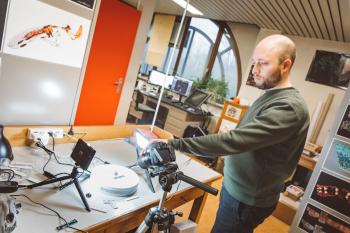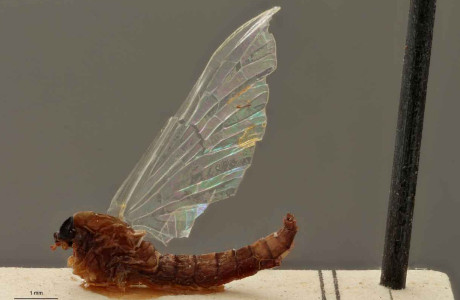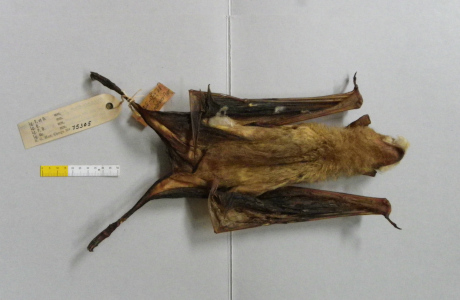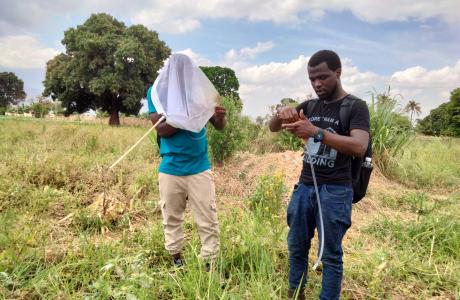Digitising collections to facilitate research on the environment and coronaviruses
The new Virtual Access programme aims to digitise the natural history collections of many European museums. The aim is to digitise, as a priority, those collections for which there is a high demand within the scientific community. The Royal Museum for Central Africa is participating in two projects. The first is to digitise some 2,400 aquatic insects in support of environmental research. The second focuses on bat collections, to provide data in the fight against coronaviruses.

I. Otto © RMCA
Natural history collections: a precious heritage...
Natural history museums house collections that are essential to meeting the most important challenge facing humanity over the next 30 years: ensuring a sustainable future for humanity and the natural systems on which we depend.
These collections contain key information to answer fundamental scientific questions about ecology, evolution and geosciences.
... still poorly digitised
Although the collections are public and searchable, digitising them and making them available online would greatly improve their accessibility. In recent years, many efforts have been made in this direction.
However, the huge size of the collections means that these efforts remain insufficient. A recent evaluation shows that only a fraction has been digitised: between 4.5 and 18% for the 8 largest natural history collections in Europe.
Digitisation on demand
The European SYNTHESYS+ programme brings together 21 partners from 13 countries. With its 10 million specimens, the Royal Museum for Central Africa is an important member.
Over the last 15 years, this network has been working to facilitate access to the collections. Within this framework, the SYNTHESYS+ consortium has launched the Virtual Access programme. This new on-demand digitisation service will provide free access to virtual collections, worldwide.
The objective of Virtual Access is to digitise, as a priority, collections for which there is a strong demand within the scientific community, in response to current societal challenges. Virtual Access also makes it possible to coordinate digitisation efforts between the various European institutions.
In the first Virtual Access call for projects, five projects were selected. The RMCA is participating in two of these projects.

Project 1: Digitisation of collections of freshwater bio-indicating insects
Freshwater habitats cover less than 1% of the planet's surface, but are home to 10% of known species.
Freshwater invertebrates play a key role as bioindicators of water and habitat health. For example, Mayflies, Stoneflies and Caddisflies rely on good quality water and surrounding terrestrial habitats. These insects are therefore used as a bioindicator: their presence and the numbers found in a habitat indicate the quality of that habitat. They are used worldwide for this purpose. The International Union for Conservation of Nature (IUCN) has therefore created a new specialist group to study these aquatic insects.
One of the first steps is to mobilise existing data. Museum collections represent a huge, untapped source of information on the distribution and life history of various organisms, including freshwater insects.
In order to facilitate research on these bioindicators and to identify valuable aquatic landscapes, the RMCA will digitise the most relevant part of its collections of freshwater invertebrates, representing about 2,400 specimens.

Project 2: Digitising bat collections to combat coronaviruses
In the context of the Covid-19 pandemic, the virus’s animal origin is a critical mystery to solve. More than 200 novel coronaviruses have been found in bats so far. But only a fraction of the known bat species have been screened for these viruses.
In the family Coronaviridae, the most similar virus to the one which causes the recent pandemic was found in a common Southeast Asian horseshoe bat species, Rhinolophus affinis. Experts suggest to accumulate our present knowledge on the distribution, viral information and basic ecological demands not only of this species but also of other bat species that are phylogenetically close to it.
In order to support studies on these viruses, more than 20,000 bat specimens held in European collections will be digitised. In this project, the RMCA will digitise the biological data of almost 2000 specimens. Researchers will develop a database containing the metadata associated with each specimen.
The five projects selected in the first Virtual Access call
The specimens and digitised data will be put online on the RMCA's virtual collections website


